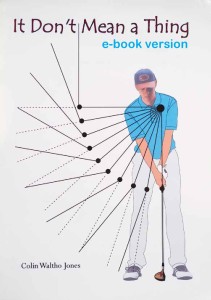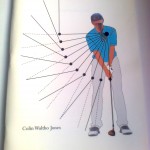This is a letter from me to John after an afternoon playing his course.
9th May 2011
Dear John,
Many thanks for a really fantastic afternoon: it was so much fun.
A few points:
1. What a fantastic course to play your golf on.
2. Thank you, again, for being a perfect pupil. Your “coachability” is truly inspiring.
3. Course management. I have been thinking about that 3-wood on the par 5 that bounced into the gorse next to the green. You “saw” the shot and hit it pretty much perfectly, yet got no reward. For me, the experience of that shot tells us that on that hole, from that side of the fairway, a lay-up is the favoured shot. That is course management; ie logging an experience and making use of it next time. However, I think that from the other side it would be worth considering a long, low 2 or 3-iron to chase up that sloping approach and green. When you are in a match you have to simply rely on your instinct as you approach the shot.
The trick is to allow all the factors to swim around in your subconscious and just allow the shot to appear to you. Beware any “shoulds” that appear in your conscious thoughts: every shot you ever play is unique; playing a shot a certain way because convention says you “should” is a sure way of turning off your subconscious. Then you commit to the vision fully. You do NOT get attached to the outcome – good or bad – because, as on the shot discussed above, if the conception and execution of the shot were as desired then the outcome is just the outcome: log it, learn from it, dust yourself down and move on.
4. Practising. The best practise is to play. If you are playing enough then you don’t need to practise. Practise should be used to try things out (like the stretch at the top of the backswing). Rules for practise:
- 20 minutes maximum. Never break this rule because it is simply not possible to switch on your sub-conscious for any longer. That’s why practise sessions deteriorate and leave you a little dissatisfied.
- Only take one club. Never break this rule because it stops you hitting balls just for the sake of hitting them.
- Go to the session with a specific aim and stick to it.
- Hit EVERY ball with full commitment to the purpose of the session and using the method fully, which means . . .
- Do NOT hit practise balls to warm up. Warm up by stretching and swinging.
5. Chipping. Your chipping is fine. Your imagination is good, your thinking is clear and your technique is sound enough to get the ball to go where you want it to go. The purpose of practising your chipping tomorrow is NOT to improve what you’ve already got but to see if you can really feel “timing” when you chip. This will come when you are able to find that lovely rhythm which results in a beautiful natural delay at the top of the backswing, when the club has come to a stop but it feels as if it is about to come back to the ball at any second, when you are able to NOT start the downswing but to just wait for the feeling that your hands are approaching the ball, and as they approach the ball that with the softest touch possible you are adding that something special that makes the ball fly to the hole.
To do this you will need to be perfectly relaxed, breathing out and not bedevilled by being attached to some previously held idea of how it is meant to be done. This last point is to try to get you out of the idea that there is a particular method ie “one-piece” take-away. You will naturally take it away in one piece anyway, just stop TRYING to make sure you are taking it away in one piece. RELAX!, your chipping is fine, we just want you to feel the ball sitting on the club and you in perfect control.
6. Putting. Get rid of that putter. Its gimmicks make you regard yourself as an inferior putter. Get yourself a Ping. They are a reasonable advance on the blade design, have stood the test of time and have the inestimable advantage of doubling up as a ball scoop! Rules of putting:
- NEVER bend down to assess the line: it is NOT how the brain works. You will rarely miss because of a wrongly chosen line – it is nearly always because of a mis-timed strike. And I know that you know that anyway; golfers just like to blame visual evidence rather than accept responsibility for what they can feel. Your assessment of line is fine: you hit a lot of very accurate long putts yesterday.
- ALWAYS visualise the ball rolling into the hole. It is a fantastically strong image and will really excite your sub-conscious.
- ALWAYS do the breathing exercise because it fits so easily into the putting routine.
- PRACTISE, PRACTISE, PRACTISE feeling the pendulum rhythm with a putter. Once you get the hang of feeling it, it is very easy to bring it back when you most need it. You can do this in the office, at home etc.
A “timed” putt will feel as if you are dragging the ball into the hole rather than hitting it at the hole. You can’t force this to happen, it is just a sign that you are starting to time the putts. A “timed” putt will roll differently; the ball will always look as if it is going at the right pace and as if it is “holding” its line.
The putting stroke is the stroke to start practising removing yourself completely from the shot. Having visualised and felt the rhythm, at the top of the backswing become conscious of the putter wanting to come back towards the ball and then consciously stay OUT of the shot. It is an odd feeling to begin with but the results can be startling. If you can get the hang of this on your putts you can start taking it to your other shots.
A practice routine for putting that is similar to the “stretch” is to get to the top of the backswing and in the moment of delay force yourself to relax your shoulder muscles. You will be amazed how much tension there is in your shoulders when you are standing over a putt.
7. Ambition. There is no reason that I can see why we shouldn’t aim for scratch. I am a little concerned that you think that you are not talented enough, or that you are somehow not worthy of the status of being a scratch golfer at Royal Porthcawl. This might be an example of your view of yourself being the main barrier to progress. When you fully accept the magic of this method you will need pressure to perform at your best, you will actively seek out tough challenges and then your natural competitiveness becomes a formidable weapon. Yesterday you basically played par golf on a blustery day with recently slowed-up greens and spending a lot of your time looking for my ball! Also, the subconscious doesn’t really respond to a friendly round on a Sunday evening. My view is that you are easily talented enough and that once we get you chipping and putting with confidence you will come down towards scratch remorselessly. Just relax and enjoy the trip!
8. Me. Many thanks for being brave enough to give me that advice. I’m going to have some fun sorting my swing out now. I also now understand your comments about the fundamentals of the swing. When I’ve thought about it a bit more we’ll have another chat.
Regards,
Colin


